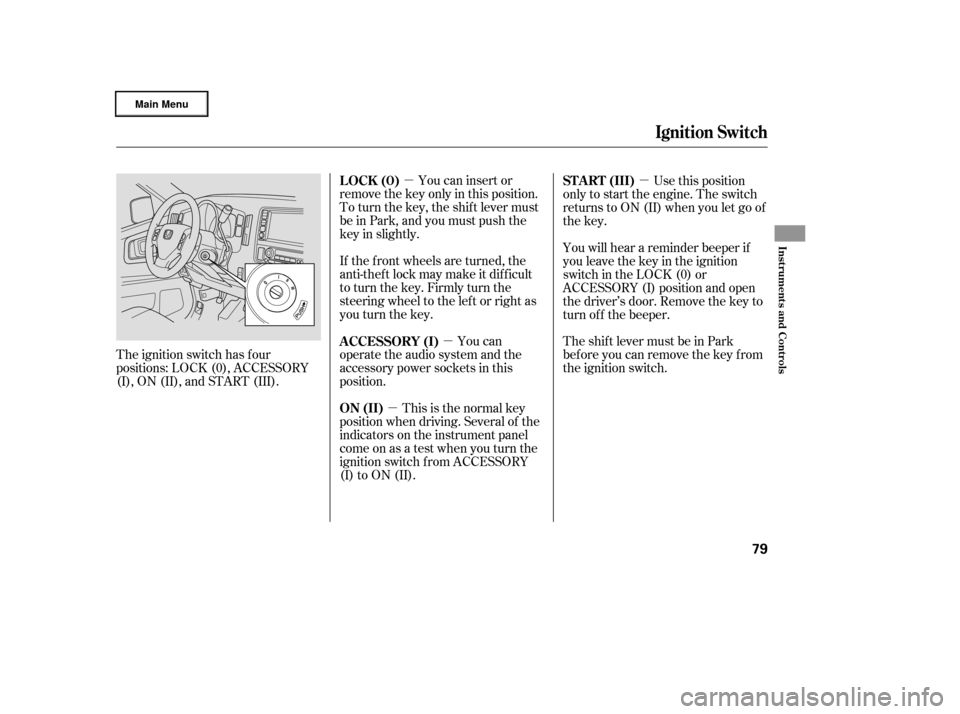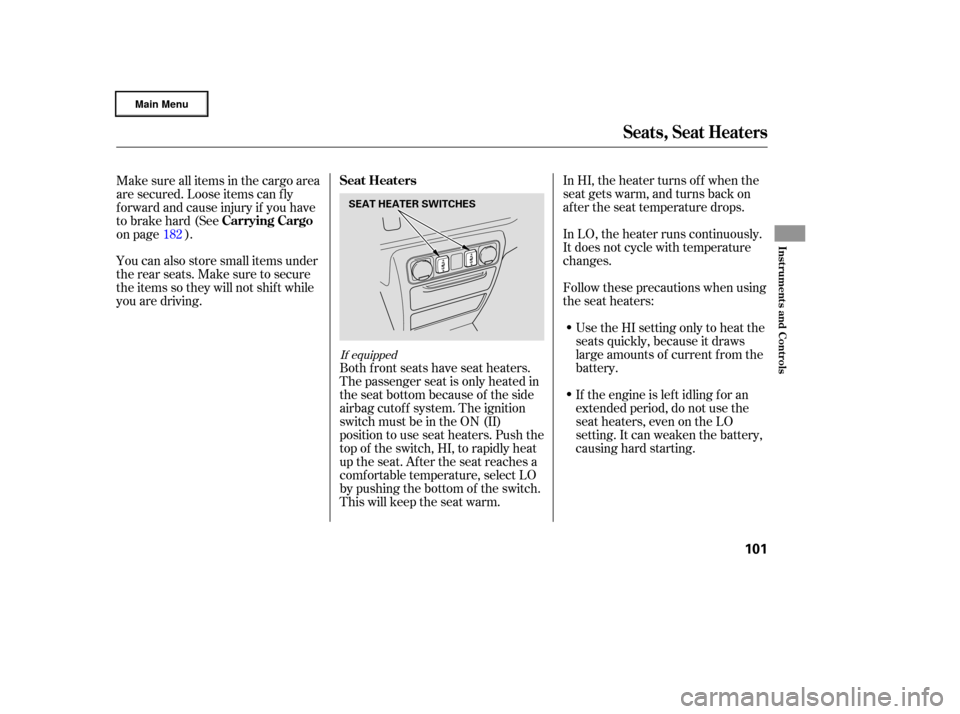Page 70 of 320
To switch the information display
between the odometer, trip meter
and outside temperature (if
equipped), and engine oil lif e and
maintenance service items, press the
SELECT button repeatedly.
This shows the total distance your
vehicle has been driven. It measures
miles in U.S. models and kilometers
in Canadian models.
It is illegal under U.S. f ederal law and
Canadian provincial regulations to
disconnect, reset, or alter the
odometer with the intent to change
the number of miles or kilometers
indicated.
Gauges
Odometer
Inst rument s and Cont rols
67
SPEEDOMETER
TACHOMETER TEMPERATURE GAUGE
ODOMETER/
CHECK FUEL CAP
INDICATORFUEL GAUGE
SELECT
BUTTON
TRIP METER RESET
BUTTON
OUTSIDE
TEMPERATURE
INDICATOR
U.S. model is shown. INFORMATION
DISPLAY
�����—�
���—�����y�
�������������y���
�(�����������y���������y
Page 71 of 320

This meter shows the number of
miles (U.S.) or kilometers (Canada)
driven since you last reset it.
There are two trip meters: TRIP A
and TRIP B. Switch between these
displays by pressing the SELECT
button repeatedly. Each trip meter
works independently, so you can
keep track of two dif f erent distances.To reset a trip meter, display it, and
then press and hold the RESET
button until the number resets to
‘‘0.0’’. Both trip meters will reset if
the vehicle’s battery goes dead or is
disconnected. And both continue to
track mileage, even when only one is
displayed.
This shows how much f uel you have.
It may show slightly more or less
than the actual amount. Driving
uphill or make turns can cause the
needle to f luctuate or the low f uel
indicator to come on early. The
needle returns to the bottom after
you turn of f the ignition.
Trip Meter Fuel Gauge
Gauges
68
SELECT BUTTON
RESET BUTTON
Avoid driving with an extremely low
f uel level. Running out of f uel could
cause the engine to misf ire, damaging
the catalytic converter.
�����—�
���—�����y�
�������������y���
�(�����������y���������y
Page 72 of 320

�¶�¶�µ�µ
�µ�µ�µ
�µ�µ�µ
This shows the temperature of the
engine’s coolant. During normal
operation, the pointer should rise
from the bottom white mark to about
the middle of the gauge. In severe
driving conditions, such as very hot
weather or a long period of uphill
driving, the pointer may rise to the
upper zone. If it reaches the red
(hot) mark, pull saf ely to the side of
the road. See page f or
instructions and precautions on
checking the engine’s cooling
system. This indicator displays the outside
temperature in Fahrenheit (U.S.
models) or Centigrade (Canadian
models).
The temperature sensor is in the
f ront bumper. Theref ore, the
temperature reading can be af f ected
by heat ref lection f rom the road
surf ace, engine heat, and the
exhaust f rom surrounding traf f ic.
This can cause an incorrect
temperature reading when your
speed is under 19 mph (30 km/h).
The sensor delays the indicator
update until it reaches the correct
outside temperature. This may take
several minutes.
If the outside temperature is
incorrectly displayed, you can adjust
it up 5°F in U.S. models ( 3°C in
Canadian models) warmer or cooler.NOTE: The temperature must be
stabilized bef ore doing this
procedure.
To adjust the outside temperature
indicator, make sure the outside
temperature indicator is shown in
thedisplay,thenpressandholdthe
RESET button f or 10 seconds (the
TRIP A or B is also reset). The
f ollowing sequence will appear f or 1
secondeach:0,1,2,3,4,5, 5, 4,
3, 2, 1, 0 (U.S.) or 0, 1, 2, 3,
3, 2, 1, 0 (Canada).
When it reaches the desired value,
release the RESET button. You
should see the new outside
temperature displayed.
In certain weather conditions,
temperature readings near f reezing
(32°F, 0°C) could mean that ice is
f orming on the road surf ace.
276
If equipped
Gauges
Temperature Gauge
Outside Temperature Indicator
Inst rument s and Cont rols
69
�����—�
���—�����y�
�����������
�y���
�(�����������y���������y
Page 73 of 320

If your f uel f ill cap is loose or
missing, a ‘‘CHECK FUEL CAP’’
message appears in the odometer
display af ter you start the engine.
The message goes f rom CHECK to
FUEL CAP repeatedly. You will also
hear a beep.
Turn the engine of f , and conf irm the
f uel f ill cap is installed. If it is, loosen
the cap, then retighten it at least 3
clicks. When you restart the engine,
the message appears again. To clear
the message, press and hold the
RESET button until the odometer
display returns.If the system still detects a loose or
missing f uel f ill cap, the malf unction
indicator lamp (MIL) comes on.
Turn the engine of f , and check or
retighten the f uel f ill cap at least 3
clicks. The MIL goes out af ter 3 days
of normal driving once the cap is
tightened or replaced. If it does not
go out, have your dealer inspect the
vehicle. For more inf ormation, see
page .
The inf ormation display in the
instrument panel shows you the
engine oil lif e and maintenance
service items when the ignition
switch is in the ON (II) position. This
inf ormation helps to keep you aware
of the periodic maintenance your
vehicle needs f or continued trouble-
f ree driving. Ref er to page f or
more inf ormation.
279 225
Check Fuel Cap Indicator Maintenance Minder Display
Gauges
70
�����—�
���—�����y�
�������������y���
�(�����������y���������y
Page 80 of 320

These keys contain electronic
circuits that are activated by the
immobilizer system. They will not
work to start the engine if the
circuits are damaged.Protect the keys f rom direct
sunlight, high temperature, and
high humidity.
Donotdropthekeysorsetheavy
objects on them.
Keep the keys away f rom liquids.
If they get wet, dry them
immediately with a sof t cloth.
The master key fits all the locks on
your vehicle. The valet key works
only in the ignition and the driver’s
door lock. You can keep the glove
boxlockedwhenyouleaveyour
vehicle and the valet key at a parking
f acility.
You can also keep the In-Bed Trunk
locked by using the main switch in
theglovebox(seepage ). Youshouldhavereceivedakey
number tag with your keys. You will
need this key number if you ever
have to get a lost key replaced. Use
only Honda-approved key blanks.
94
Keys
Inst rument s and Cont rols
77
VALET KEY
(LIGHT GRAY)
MASTER KEY
WITH REMOTE
TRANSMITTER
KEY
NUMBER
TAG
�����—�
���—�����y�
���������
���y���
�(�����������y���������y
Page 81 of 320

When you turn the ignition switch to
ON (II), the immobilizer system
indicator should come on f or a f ew
seconds, then go out. If the indicator
starts to blink, it means the system
does not recognize the coding of the
key. Turn the ignition switch to
LOCK (0), remove the key, reinsert
it, and turn the switch to ON (II)
again.The system may not recognize your
key’s coding if another immobilizer
key or other metal object (i.e. key
chain) is near the ignition switch
when you insert the key.
Do not attempt to alter this system
or add other devices to it. Electrical
problems could result that may make
your vehicle undriveable.
If you have lost your key and you
cannot start the engine, contact your
dealer. If the system repeatedly does not
recognize the coding of your key,
contact your dealer.
The immobilizer system protects
your vehicle f rom thef t. If an
improperly-coded key (or other
device) is used, the engine’s f uel
system is disabled.
As required by the FCC:
This device complies with Part 15 of theFCC rules. Operation is subject to thef ollowing two conditions: (1) This devicemay not cause harmf ul interf erence, and(2) this device must accept anyinterf erence received, includinginterf erence that may cause undesiredoperation.
Changes or modif ications not expresslyapproved by the party responsible f orcompliance could void the user’sauthority to operate the equipment.
This device complies with IndustryCanada Standard RSS-210.Operation is subject to the f ollowing twoconditions: (1) this device may not causeinterf erence, and (2) this device mustaccept any interf erence that may causeundesired operation of the device.
Immobilizer System
78
�����—�
���—�����y�
�������������y���
�(�����������y���������y
Page 82 of 320

�µ�µ
�µ �µ
The ignition switch has f our
positions: LOCK (0), ACCESSORY
(I), ON (II), and START (III). You can insert or
remove the key only in this position.
To turn the key, the shift lever must
be in Park, and you must push the
key in slightly.
If the f ront wheels are turned, the
anti-theft lock may make it difficult
to turn the key. Firmly turn the
steering wheel to the lef t or right as
you turn the key.
You can
operate the audio system and the
accessory power sockets in this
position.
This is the normal key
position when driving. Several of the
indicators on the instrument panel
come on as a test when you turn the
ignition switch f rom ACCESSORY
(I) to ON (II). Use this position
only to start the engine. The switch
returns to ON (II) when you let go of
the key.
You will hear a reminder beeper if
you leave the key in the ignition
switch in the LOCK (0) or
ACCESSORY (I) position and open
the driver’s door. Remove the key to
turn of f the beeper.
TheshiftlevermustbeinPark
bef ore you can remove the key f rom
the ignition switch.
LOCK (0)
A CCESSORY (I)
ON (II) ST A RT (III)
Ignition Switch
Inst rument s and Cont rols
79
�����—�
���—�����y�
�������������y���
�(�����������y���������y
Page 104 of 320

In HI, the heater turns of f when the
seat gets warm, and turns back on
after the seat temperature drops.
In LO, the heater runs continuously.
It does not cycle with temperature
changes.
Follow these precautions when using
the seat heaters:Use the HI setting only to heat the
seats quickly, because it draws
large amounts of current f rom the
battery.
If the engine is lef t idling f or an
extended period, do not use the
seat heaters, even on the LO
setting. It can weaken the battery,
causing hard starting.
Make sure all items in the cargo area
are secured. Loose items can f ly
f orward and cause injury if you have
to brake hard (See
on page ).
You can also store small items under
the rear seats. Make sure to secure
the items so they will not shift while
you are driving.
Both front seats have seat heaters.
The passenger seat is only heated in
the seat bottom because of the side
airbag cutoff system. The ignition
switch must be in the ON (II)
position to use seat heaters. Push the
top of the switch, HI, to rapidly heat
up the seat. After the seat reaches a
comf ortable temperature, select LO
by pushing the bottom of the switch.
This will keep the seat warm.
182
If equipped
Seat Heaters
Carrying Cargo
Seats, Seat Heaters
Inst rument s and Cont rols
101
SEAT HEATER SWITCHES
�����—�
���—�����y�
���������
���y���
�(�����������y���
�����y